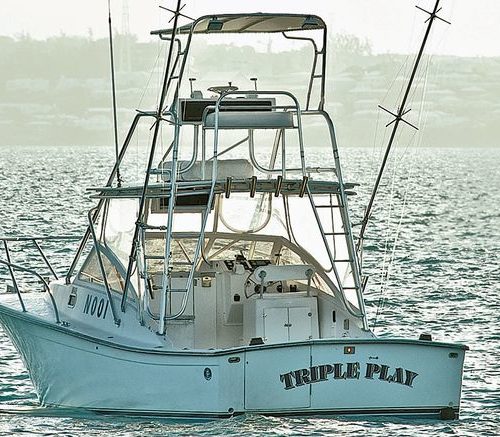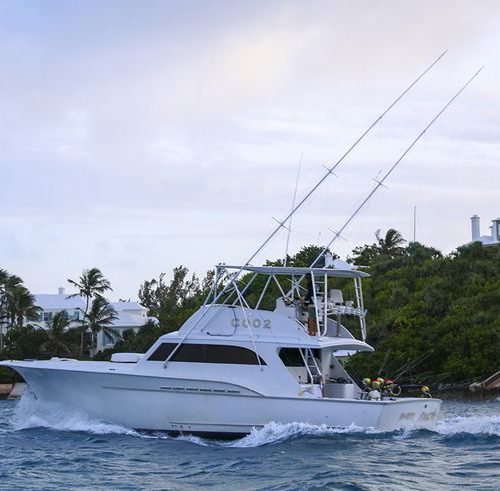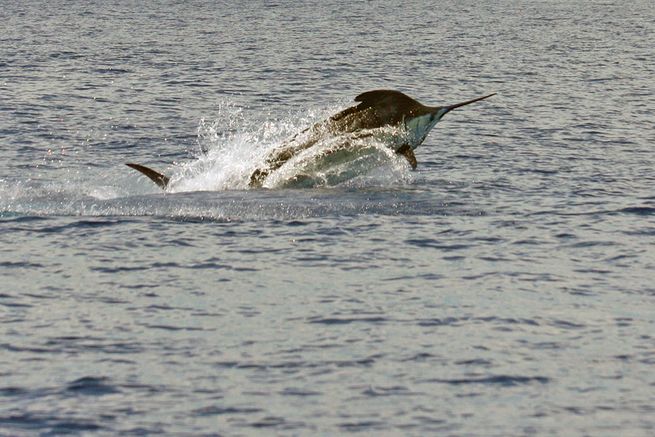
Angling opportunities abound both offshore and inshore in Bermuda.

A wealth of angling excitement awaits in Bermuda, once the marlin tournaments are over. While blue marlin claim the lion’s share of the glory and attention, the waters around Bermuda abound in big game without beaks; especially notable are the tuna and wahoo fisheries. They may appear as incidental catches while you are marlin fishing, but they are, in their own right, year-round targets of opportunity with their own share of challenges, excitement and table appeal for anyone who ventures offshore.
Year after year, Bermuda is productive for both tuna and wahoo, with some uncharacteristically high numbers posted in the last decade.
Especially notable was the one-day tally of 51 wahoo by Capt. James Robinson on June 2, 2011. The new daily record was well beyond the previous record total of 43 wahoo in a day.
Robinson, a veteran charter boat captain and tournament winner, explains that 2011’s high numbers were due to exceptional current carrying bait into the area.
“[2011] was special due to currents. Like everywhere else in the world, everything here is current driven, and it gets good when we get good upwellings,” he says.
The trick to fishing tuna and wahoo is to focus on the seamounts, or banks, Robinson says. “We have two seamounts offshore, Challenger and Argus, and the island is a seamount as well; it just has its top sticking out. Most tuna are on the banks, and everything is on the upcurrent side. We fish around the points on the upcurrent side of the banks.”
Just how those points are fished depends on how the fish are feeding and on the season. “In winter, the fishery was all trolling until the spring, then when it hit summer it was all chumming,” says Robinson. When chumming and chunking to draw the fish to the boat, some skippers prefer to anchor up while others like to drift over the likely spots, setting up a chum line with a combination of baitfish and chunks.
During the winter and spring, tuna from 20 to 80 pounds are the most common catch. As summer comes on, the bigger tuna, over 100 pounds, are usually taken on trolled ballyhoo and flying fish, cedar plugs and spreader bars. When conditions are right and the fish are feeding on the surface, kite fishing is also effective. “Guys do a bit of kite fishing,” he states. “We rig a flying fish so the wings are spread with wire and let it bob on the waves. That’s effective when the tuna are busting on top.”
Casting plugs to them works too when they are on the surface. “Popping for them is either on or off. When it’s on, it’s on, it works, and when it’s not, you are better off trolling.”
The biggest tuna, says Robinson, show up in August and generally are taken on ballyhoo and flying fish.
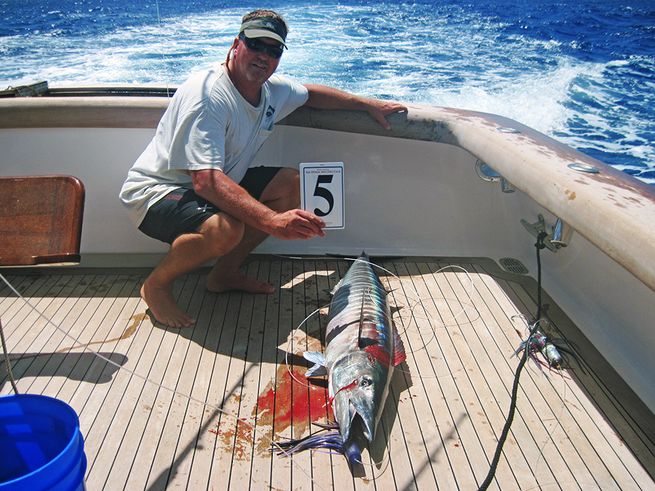
Yipes Stripes!
Wahoo are often interlopers on a tuna-targeted chumline, and are welcome ones at that. “When you start losing hooks in the tuna chum line, you know the wahoo are here, and it’s time to rig with wire,” says Robinson. He prefers a long piece of wire and a J-hook, fishing on a long, whippy rod carrying 20-pound mono line when chum fishing for wahoo. ”Catching wahoos in the chum on light line, sight-fishing them this way, is phenomenal.”
Trolling is a different story. The standard wahoo setup is a five-rod spread: two downriggers, two rods with 6- to 8-ounce trolling weights and a popping plug. “Last winter we trolled for wahoo at 9 knots, pulling Sea Witches, Ilanders, Hawaiian Is, Big T jets, metal jet heads: any type of straight-running bullet-head lures.”
December through February is top time for wahoo. And the winter wahoo are the biggest. While summer fish average 30 to 50 pounds, the winter fish can hit up to 130 pounds.
If a fight with that much toothy predator doesn’t sound exciting enough, just wait until those wahoo steaks hit the grill!
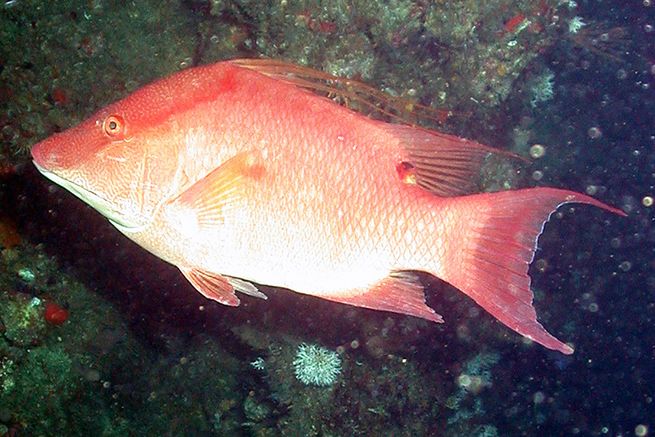
Inshore
There’s more to Bermuda than bluewater, and anglers who spend some time poking around the edges of the island soon find that out. What they find is not only world class, in the case of bonefishing, but what is perhaps the world’s only flats fishing for hogfish as well.
Sight-casting is a specialty game, and Ian Linnel, skipper of Jump Dem Bones, is a dedicated specialist when it comes to honing the skills required to sight-fish big fish in very shallow water. In fact, he was one of the first anglers, and guides, to recognize the rare opportunity of sight-fishing for hogfish in these waters.
Hogfish are a well-known denizen of the reefs and hard-bottom inshore waters. Their spectacular appearance — ranging from cream to a soft red, set off by a purple band running from their elongated nose to the flowing streamers emanating from the dorsal — is unmistakable. And only in Bermuda, it seems, are the flats part of their hunting grounds. Here they move up onto the hard sand flats to root for worms buried in the sand bottom, says Linnel, who pioneered this fishery.
“You’ll find them in anywhere from one to three feet of water,” Linnel expounds. “Usually you see their tails sticking up when they root on the bottom.” Most of the fish his customers take average 7 or 8 pounds, but they will occasionally push the 18- and 20-pound mark.
While tailing fish in moderate depths are the rule, Linnel says the shallowest he has seen hogfish was one particular fish that was pushing so hard up onto the flat that everything behind its eyes was above water, thrashing on the surface.
When they are feeding like this, Linnel has his customers drop a shrimp or a live crab in front of the fish. When its head comes up after rooting, if there is a crab in front of its face, the hogfish can seldom resist. All of his fishing is done with spinning tackle and 12-pound line, hefty enough to do the hard work yet light enough to offer stealth and plenty of sport on these exotic fish. And yes, hogfish are as delicious on the table as they are sporty on the flats.
While Linnel specializes in hogfish, the mainstay on the flats in Bermuda is bonefish, well known to anglers in the Bahamas, Florida and the Caribbean, but likely to be quite unexpected this far north. But the warm waters of the Gulf Stream that bathe the island, and the abundance of inviting habitat, make this an ideal spot to hunt trophies.
“The bonefish here average 7 to 12 pounds,” says Linnel, a fact that puts Bermuda in the big leagues alongside south Florida and the Keys in terms of exceptional average size of fish. In fact, the fish here are probably a bit larger on average. The flats around the island are mostly hard, sandy bottom, and the fish hunt them alone or in pairs, occasionally more. You won’t find big schools of fish like the Bahamas, but they can be counted on to show up and give the angler honest shots with a jig or a fly. Wiggle jigs, skimmers, the lures that are effective elsewhere for bonefish also do the job in these flats. If bonefish will hit it in the Bahamas or the Florida Keys, they will hit it here too. Fly-fishermen do well on flies like Crazy Charlies and Gotchas, and of course, some local specialties that you’ll only learn about when fishing with the local experts.
There are plenty of areas to fish and abundant variety in the warm Gulf Stream waters around Bermuda. It may be a tough choice to have to make on any given day. You may prefer to stay with the bluewater, to seek your variety with brawny pelagics on heavy gear; then again there’s the special challenge of sight-fishing, more akin to hunting, and the challenge of the shallows with light tackle and fly gear.
The best part is no matter what you choose, there’s no bad decision.
